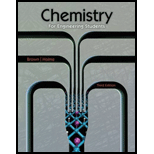
Interpretation:
Ions which are typically exchanged in a water softening system should be recognized along with a conclusion about the relative numbers of various ions involved given that the ion exchanger cannot build up a large positive charge.
Concept introduction:
Water softening means removal of calcium, magnesium ions salts from hard water. Because of these two ions, basicity will increase in the water.
Hard water cannot be used for drinking, because it could form precipitates in our body. Drinking hard water is a waving hand for very dangerous diseases.
So, we have to remove these ion containing salts. Water hardening can be divided into two; permanent hardening and temporary hardening. We can use many methods to remove this ion salts. One of the removing processes is using a resin. This is a healthy method.
Want to see the full answer?
Check out a sample textbook solution
Chapter 2 Solutions
Chemistry for Engineering Students
- From the following written description, write the balanced chemical equation for the reaction including state symbols. A diatomic gaseous molecule that contains 17 protons per atom is reacted with a solid element that has an atomic number of 19 to yield an ionic compound.arrow_forwardIn a hypothetical universe, an oil-drop experiment gave the following measurements of charges on oil drops: 5.55 1019 C, 9.25 1019 C, 1.11 1018 C, and 1.48 1018 C. Assume that the smallest difference in charge equals the unit of negative charge in this universe. What is the value of this unit of charge? How many units of excess negative charge are there on each oil drop?arrow_forward7.101 Lead selenide nanocrystals may provide a breakthrough in the engineering of solar panels to be efficient enough to be an economical source of electricity. Selenium is generally considered a nonmetal while lead is considered a metal. Is this distinction enough to suggest that this compound should be ionic? Explain your answer.arrow_forward
- Naturally occurring nitrogen is a mixture of 14N and 15N. Give the number of protons, neutrons, and electrons in the neutral atom of each isotope.arrow_forwardGiven that the periodic table is an organizational scheme for the elements, what might be some other logical ways in which to group the elements that would provide meaningful chemical information in a periodic table of your own devising?arrow_forward3 If element A has a charge of 3 and element B has a charge of -2 what would the proper ionic formula be for their combination?arrow_forward
- An engineer is designing a water softening unit based on ion exchange. Use the web to learn what ions typically are “exchanged” in such a system. Given that the ion exchanger cannot build up a large positive charge, what can you conclude about the relative numbers of the various ions involved?arrow_forwardA student in your chemistry class tells you that nitrogen-14 and nitrogen-15 are not isotopes because they have the same number of protons. How would you refute this statement?arrow_forward2-27 If each atom in Problem 2-26 acquired two more neutrons, what element would each then be?arrow_forward
 Chemistry for Engineering StudentsChemistryISBN:9781337398909Author:Lawrence S. Brown, Tom HolmePublisher:Cengage Learning
Chemistry for Engineering StudentsChemistryISBN:9781337398909Author:Lawrence S. Brown, Tom HolmePublisher:Cengage Learning General Chemistry - Standalone book (MindTap Cour...ChemistryISBN:9781305580343Author:Steven D. Gammon, Ebbing, Darrell Ebbing, Steven D., Darrell; Gammon, Darrell Ebbing; Steven D. Gammon, Darrell D.; Gammon, Ebbing; Steven D. Gammon; DarrellPublisher:Cengage Learning
General Chemistry - Standalone book (MindTap Cour...ChemistryISBN:9781305580343Author:Steven D. Gammon, Ebbing, Darrell Ebbing, Steven D., Darrell; Gammon, Darrell Ebbing; Steven D. Gammon, Darrell D.; Gammon, Ebbing; Steven D. Gammon; DarrellPublisher:Cengage Learning Chemistry: Principles and PracticeChemistryISBN:9780534420123Author:Daniel L. Reger, Scott R. Goode, David W. Ball, Edward MercerPublisher:Cengage Learning
Chemistry: Principles and PracticeChemistryISBN:9780534420123Author:Daniel L. Reger, Scott R. Goode, David W. Ball, Edward MercerPublisher:Cengage Learning Introduction to General, Organic and BiochemistryChemistryISBN:9781285869759Author:Frederick A. Bettelheim, William H. Brown, Mary K. Campbell, Shawn O. Farrell, Omar TorresPublisher:Cengage Learning
Introduction to General, Organic and BiochemistryChemistryISBN:9781285869759Author:Frederick A. Bettelheim, William H. Brown, Mary K. Campbell, Shawn O. Farrell, Omar TorresPublisher:Cengage Learning Introductory Chemistry: A FoundationChemistryISBN:9781337399425Author:Steven S. Zumdahl, Donald J. DeCostePublisher:Cengage Learning
Introductory Chemistry: A FoundationChemistryISBN:9781337399425Author:Steven S. Zumdahl, Donald J. DeCostePublisher:Cengage Learning Chemistry: The Molecular ScienceChemistryISBN:9781285199047Author:John W. Moore, Conrad L. StanitskiPublisher:Cengage Learning
Chemistry: The Molecular ScienceChemistryISBN:9781285199047Author:John W. Moore, Conrad L. StanitskiPublisher:Cengage Learning





